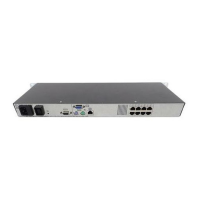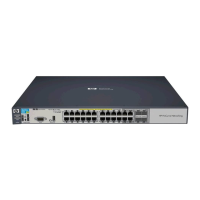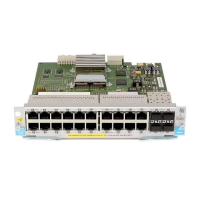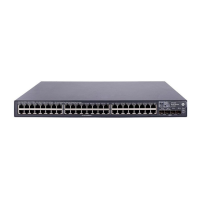112
Step Command Remarks
2. Enter interface
view or port
group view.
• Enter Layer 2 Ethernet interface
view:
interface interface-type
interface-number
• Enter Layer 2 aggregate
interface view:
interface bridge-aggregation
interface-number
• Enter port group view:
port-group manual
port-group-name
Use any command.
• The configuration made in Ethernet
interface view applies only to the port.
• The configuration made in port group
view applies to all ports in the port
group.
• The configuration made in Layer 2
aggregate interface view applies to
the aggregate interface and its
aggregation member ports. If the
system fails to apply the configuration
to the aggregate interface, it stops
applying the configuration to
aggregation member ports. If the
system fails to apply the configuration
to an aggregation member port, it
skips the port and moves to the next
member port.
3. Configure the
link type of the
ports as hybrid.
port link-type
hybrid
By default, all ports are access ports.
To change the link type of a port from trunk
to hybrid or vice versa, you must set the link
type to access first.
4. Assign the
hybrid ports to
the specified
VLANs.
port hybrid
vlan
vlan-list {
tagged
|
untagged
}
By default, a hybrid port allows only
packets of VLAN 1 to pass through
untagged.
5. Configure the
PVID of the
hybrid ports.
port hybrid pvid vlan
vlan-id
Optional.
By default, the PVID is VLAN 1.
NOTE:
• Before you assign a hybrid port to a VLAN, create the VLAN.
• After configuring the PVID for a hybrid port, you must use the port hybrid vlan command to
configure the hybrid port to allow packets from the PVID to pass through, so that the egress por
can forward packets from the PVID.
Port-based VLAN configuration example
Network requirements
As shown in Figure 35:
• Host A and Host C belong to Department A, and access the enterprise network through different
devices. Host B and Host D belong to Department B. They also access the enterprise network
through different devices.
• To ensure communication security and avoid broadcast storms, VLANs are configured in the
enterprise network to isolate Layer 2 traffic of different departments. VLAN 100 is assigned to
Department A, and VLAN 200 is assigned to Department B.
• Make sure that hosts within the same VLAN can communicate with each other. Host A can
communicate with Host C, and Host B can communicate with Host D.
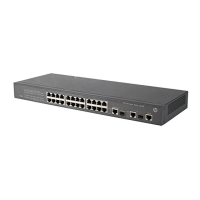
